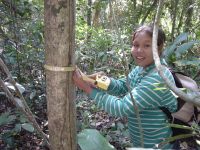Wednesday, April 24, 2024
News and Views from the Global South

ENVIRONMENT: Forests at a Climate Crossroads
Stephen Leahy* - Tierramérica
- Billions of dollars are being mobilised to protect and increase the world’s forests under a climate protection mechanism known as REDD (Reduced Emissions from Deforestation and Degradation). But many experts are unsure that it will work, and some fear it could end in disaster.

Measuring a tree trunk in the Guarayos forest in eastern Bolivia. Credit: Courtesy CIFOR/Kristen Evans
“Most countries are simply not ready. They do not have policies to protect the rights of local and indigenous peoples, to determine land tenure or even work out who owns the ‘carbon rights’ to a forest,” Larson told participants at an international conference on smallholder and community forestry in Montpellier, France, in late March.
Under the REDD initiative, richer countries would pay to maintain forests in tropical regions to offset their own carbon emissions. Carbon dioxide from human activities is one of the main gases that produce the greenhouse effect.
They wealth countries would be granted “carbon credits” towards achieving their carbon reduction commitments to combat climate change.
About 20 percent of global greenhouse gas emissions come from deforestation – more than the entire transportation sector worldwide.
At the United Nations-sponsored Copenhagen climate talks in December, six countries, including the United States and France, announced 2.6 billon euros (3.5 billion dollars) of financing for REDD+ programmes for 2010-2012, including conservation and the enhancement of carbon stocks in existing forests.
In late March another billion dollars was promised and a 10-nation steering group established to drive the implementation of a REDD+ global programme. It could be approved at the next annual United Nations climate conference, to take place in Cancun, Mexico.
That may be too soon in Larson’s estimation, based on a three-year study in 10 countries documenting the evolution of granting of land rights to smallholder forest communities throughout tropics over the last 20 to 25 years.
“Even when states grant land tenure to local people, it often happens that the states do not support or respect those rights,” she told Tierramérica.
The study “Forests for People: Community Rights and Forest Tenure Reform” was presented at the Montpellier conference, organised by CIFOR and two French entities.
Despite various land reform policies in recent decades that officially acknowledged local people’s rights and tenure, it made little difference in many regions due to legal loopholes, lack of enforcement, corruption and government bureaucracy, Larson said.
“Yes, there are new opportunities for some communities, but the granting of rights is not something we can say has solved the problem,” she said.
There are big questions regarding designing and implementing REDD, according to Larson. Most countries are only looking at it from a national level and are not taking impacts on local communities into account.
States have not worked out fair and equitable mechanisms for sharing the revenue and benefits from such programmes, leading Larson to wonder: “Who is going to decide who gets all this money?”
On the other hand, deforestation has been relentless, eating up 13 to 16 million hectares every year for the last few decades. Although the UN Food and Agriculture Organisation (FAO) reported at the end of March that the deforestation rate over the past decade has been at the low end of the scale, averaging 13 million hectares per year.
“Nothing else has stopped deforestation – perhaps REDD will,” says Larson. That makes REDD both a huge opportunity and a huge risk, in her opinion.
There is a great deal of speculation about REDD, according to David Bray, professor in the Department of Earth and Environment at Florida International University.
REDD is a very complex undertaking and “the carbon markets want verifiable credits,” Bray told Tierramérica.
Verification of how much carbon is in a forest and how much carbon is retained over 40, 60 or 80 years is very technical, “and it will be very difficult for local communities to do,” Bray said.
Several REDD pilot projects are under way as part of the 50-million-dollar UN-REDD programme designed to assist developing countries determine how they can be implemented to benefit nations, forests and forest communities.
One such project is in the Budongo Forest, a tropical forest in northwestern Uganda.
Glenn Bush, an environmental economist at Woods Hole Research Centre in the U.S., conducted research in the forest communities to determine if revenues from REDD would offset the costs for local people giving up their traditional use of the forests.
“It is a very complex at the local level. It depends on the local situation and even the time of year,” Bush told the Montpellier conference, Mar. 24-26.
“There are times of the year, such as during droughts, when no amount of money can provide what people really need, such as the food and water they get from the forest,” he said.
(*This story was originally published by Latin American newspapers that are part of the Tierramérica network. Tierramérica is a specialised news service produced by IPS with the backing of the United Nations Development Programme, United Nations Environment Programme and the World Bank.)

 Print
Print



